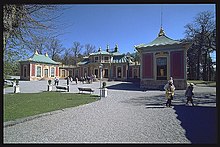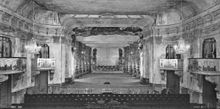Drottningholm Palace
| Royal Domain of Drottningholm | |
|---|---|
|
UNESCO world heritage |
|

|
|
| General plan of the palace complex |
|
| National territory: |
|
| Type: | Culture |
| Criteria : | (iv) |
| Reference No .: | 559 |
| UNESCO region : | Europe and North America |
| History of enrollment | |
| Enrollment: | 1991 (session 15) |
Drottningholm Palace (Queen's Island ) was originally a royal pleasure palace on the island of Lovön in Mälaren in the municipality of Ekerö . Today, in addition to its museum use, it is also the private residence of the Swedish royal family Bernadotte , currently of King Carl XVI. Gustaf and his wife Silvia , who moved into the south wing as their main residence in 1982 and since then have only used Stockholm Palace as an official residence and for representative purposes.
Drottningholm stands since 1935 as Byggnadsminne under state protection and became the first Swedish cultural monument in the List of World Heritage of UNESCO received due two special buildings, the Chinese small castle (Kina slott) and Drottningholmtheaters (Drottningholms Slottsteater) .
Drottningholm Palace is also known as the "Swedish Versailles".
history
Johann III. von Sweden had a castle built in 1580 for his wife Katharina Jagiellonica (Catherine of Poland), who was then Queen of Sweden. He called it "Queen Island" - "Drottningholm". In 1661 the widow of the Swedish King Karl X. Gustav , Hedwig Eleonora von Schleswig-Holstein-Gottorf , acquired the castle, which burned down to the foundation walls on December 30, 1661 .
She had a new palace built according to plans by the architect Nicodemus Tessin the Elder. Ä. build in baroque style. His son Nicodemus Tessin the Elder J. took over the construction management after his father's death shortly before the completion of the construction in 1681 and completed the castle and castle church (has a Cahman organ from 1730) and laid out a baroque garden based on the French model. The park was later expanded to the west. From 1777 Gustav III. to create an English landscape garden to the north, whose gardener was Fredrik Magnus Piper .
In the 1760s, Queen Lovisa , the wife of King Adolf Friedrich , had a number of new buildings built according to plans by the architect Carl Fredrik Adelcrantz , including the Chinese castle and Drottningholms Schlosstheater with the original stage machinery .
The Chinese castle (Kina slott) is built in the French Rococo style, but has an exotic finish due to the numerous Chinese and oriental elements.
The castle theater
The palace theater is one of the best preserved baroque theaters in Europe. It was built as a successor to a theater that burned down in 1762 by the architect Carl Fredrik Adelcrantz for the Swedish Queen Luise Ulrike of Prussia and inaugurated in 1766. It reached its peak under Gustav III, who wrote plays himself and enjoyed acting as an actor. During his time, the theater was expanded to the west with the so-called Déjeunersalongen (breakfast salon).
After an assassination attempt on Gustav III. During a masked ball at the Stockholm Opera , from the consequences of which he died shortly afterwards, the theater fell into disrepair and was only rediscovered at the beginning of the 20th century and renovated in 1922. The stage technology is still original. The theater has a unique collection of 30 sets . Today the stage is used again for performances, for example in 2011 for a faithful representation of the Così fan tutte by Wolfgang Amadeus Mozart staged by Sigrid T'Hooft . The theater is a stop on the Nordic Route of the European Route of Historic Theaters .
More royal castles
In addition to the Drottningholm Palace, there are a larger number of other royal palaces and parks in Sweden: The Stockholm Royal Palace (the official residence of the King), Gripsholm Castle , Rosendal Palace , Rosersberg Palace , strömsholm palace , Schloss Tullgarn , Ulriksdal Palace , the Haga Park (Haga Castle is Residence of the Crown Princess) as well as the park of the royal summer villa Solliden , which was built near Borgholm Castle , which has only survived as a ruin .
Literature and film
- Nils Gustaf Wollin: Drottningholms lustträdgård och park. Le jardin d'agrément et le parc de château royal de Drottningholm. En konsthistorisk undersökning. Bröderna Lagerströms, Stockholm 1927.
- Hartmut Schwenk (Director): Drottningholm, Sweden: Island of the Queens. Documentation, D, 15 min., In the series Treasures of the World - Heritage of Mankind. Films about the UNESCO World Heritage.
Web links
- Entry on the UNESCO World Heritage Center website ( English and French ).
- Official website (English)
- Treasures of the world: Royal Summer Palace Drottningholm ( Memento from March 25, 2002 in the Internet Archive )
- 3sat theme day "Around the world in 24 hours"
- Entry in the bebyggelseregistret des Riksantikvarieämbetet (Swedish)
Coordinates: 59 ° 19 ′ 18 ″ N , 17 ° 53 ′ 10 ″ E







